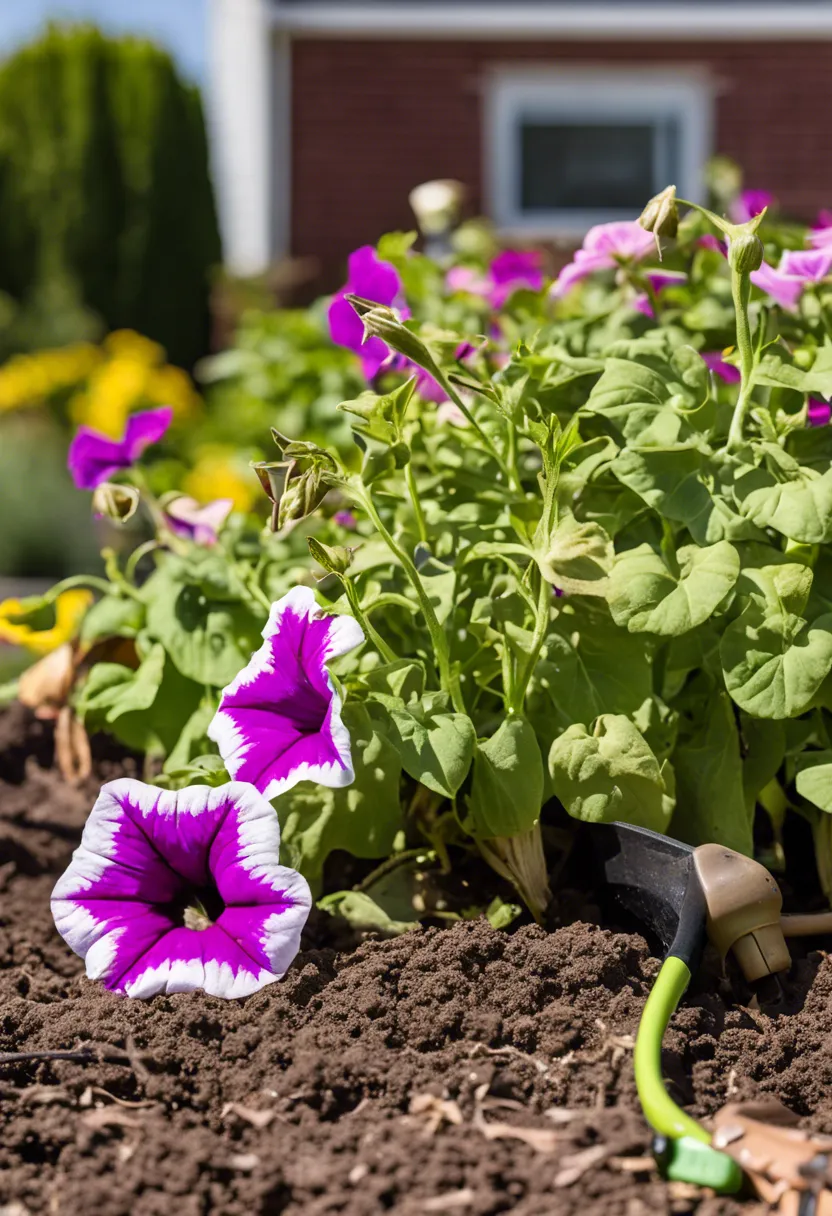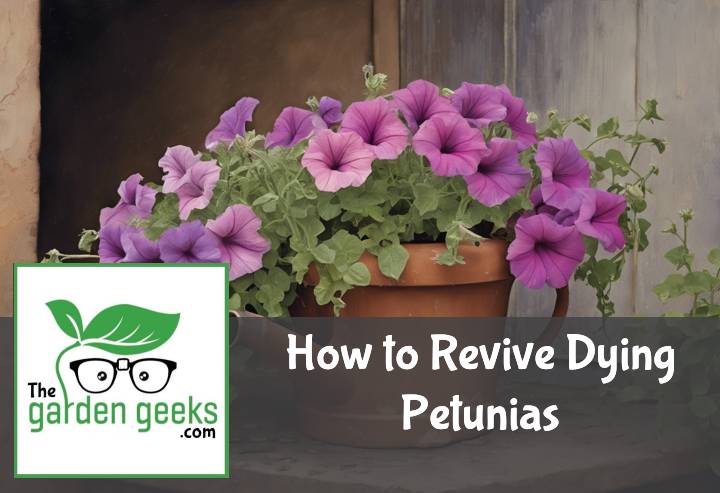Did you know that petunias are one of the most popular flowers in the United States? But, despite their popularity, these vibrant blooms can sometimes struggle to survive. If you’ve ever found yourself wondering How to Revive Dying Petunias, you’re not alone.
In fact, many gardeners experience this challenge. Petunias are delicate flowers that require specific care and conditions to thrive. They may start showing signs of distress due to various factors such as inadequate watering, nutrient deficiencies or pests.
But don’t worry! There’s always a way to bring your dying petunias back to life. Keep reading about How to Revive Dying Petunias and discover how you can restore their former glory.
Quick Answer
- Identify the signs of dying petunias like wilting, yellowing, or browning.
- Understand the causes of decline such as inadequate watering, nutrient deficiencies, soil problems, pests and diseases.
- Follow a step-by-step revival guide which includes adjusting watering practices, improving soil conditions and treating pest or disease issues.
- Implement preventative measures for healthy petunias like proper planting techniques and regular maintenance schedule.

Identifying the Signs of Dying Petunias
Visual Symptoms of Distress
Spotting a dying petunia isn’t rocket science, but it does need your eyes wide open. First off, if your petunias look more like sad, wilted lettuce than vibrant flowers, that’s a red flag. Leaves turning yellow or brown and dropping faster than hot potatoes are classic visual symptoms of a plant in distress. Noticing these changes early can make all the difference.
Another tell-tale sign is when blooms start to look as if they’ve seen better days – fewer flowers or ones that seem to give up before fully opening. This could be your petunia waving a white flag. Also, keep an eye out for any unusual spots or marks on the leaves and stems. These could be the sneaky signs of disease or pest attacks.
Common Environmental Stressors
Petunias are pretty tough cookies, but even they have their kryptonite. Too much sun can turn them into crispy critters, while not enough will leave them leggy and sad-looking. Finding that Goldilocks zone of just-right sunlight is key.
Water woes are another biggie. Overwatering leads to soggy roots and unhappy plants. Underwatering? Well, that’s just asking for trouble in the form of droopy, thirsty petunias begging for a drink.
Don’t forget about where you’re planting them either. Poor soil can be like making them live in a junk food diet – no good nutrients means no good growth. And lastly, crowded conditions can spark drama in the petunia world, leading to more stress and less blooming.
Understanding these common environmental stressors helps you play detective with your petunias’ health. By keeping an eye out for these issues, you’re one step closer to reviving those dying beauties back to life!
Causes of Decline in Petunias
Petunias can brighten up any garden, but when they start to look sad, it’s usually due to a few common issues.
Inadequate Watering Practices
Overwatered petunia symptoms include leaves that are soft and mushy. It’s like giving your petunias too much to drink; their roots can’t breathe! On the flip side, underwatered petunia signs show up as dry, crispy leaves. They’re basically thirsty and begging for a drink. The trick is finding that sweet spot for proper watering for petunias. They like their soil moist but not soggy. Think of it as making a moist chocolate cake – you want it just right.
To correct overwatering, let the soil dry out a bit before giving them another drink. For underwatered flowers, slowly reintroduce water without flooding them. It’s all about balance to meet the water requirements of petunias.
Nutrient Deficiencies and Soil Problems
If your petunias are looking a bit off, the soil might be the culprit. Just like us needing vitamins, petunias need nutrients from their soil to thrive. Signs of nutrient deficiency in petunias include yellow leaves or stunted growth. It’s their way of saying they’re hungry for more!
Improving your garden’s dirt can be simple. Mixing in compost or a balanced fertilizer can give your soil—and your petunias—the boost they need. This helps create the ideal soil requirements for healthy petunias, ensuring they have access to all those tasty nutrients they crave.
Pests and Disease Issues
Ever notice holes in your petunia leaves or flowers that just don’t look right? You might have uninvited guests. Aphids and spider mites are common pests affecting petunias, turning your beautiful blooms into an all-you-can-eat buffet.
Then there’s disease – things like root rot or powdery mildew can make petunias wilt or die if not caught early. Keeping an eye out for early signs of pests and disease in petunias is key to keeping them healthy.
Preventing these issues starts with good garden hygiene—remove dead leaves and avoid overhead watering to keep leaves dry. If pests or diseases do show up, treating them early with soap sprays or fungicides can save your blooms.



Step by Step Revival Guide for Dying Petunias


Reviving dying petunias might seem like a task for a green thumb magician, but guess what? You can do it too! With a bit of love, some water tricks, and the right sunlight dance, your petunias will be back to their blooming best. Let’s jump straight into the how-to without any magic spells needed.
-
Check the soil moisture: First things first, poke your finger into the soil around your petunias. If it feels dry as a desert, that’s a no-go. Your petunias are thirsty! Give them a good drink of water but don’t turn their home into a swamp.
-
Trim the dead stuff: Snip away any dead or dying flowers and leaves. This isn’t just about making your plant look pretty; it’s like telling your petunias, “Hey, focus on the good stuff!” It encourages them to put energy into new growth.
-
Move to a sunnier spot: Petunias love the sun more than teenagers love their phones. If your plant isn’t getting at least 6 hours of direct sunlight each day, find it a new sunny spot where it can soak up those rays.
-
Fertilize wisely: Grab some fertilizer that’s made for flowers (it should say so on the package) and give your petunias a meal following the instructions on the label. Don’t overdo it though; think nutritious snack, not an all-you-can-eat buffet.
-
Water in the morning: Watering your petunias in the morning gives them time to drink up before the heat of the day. It also helps prevent diseases that can happen if they stay wet overnight.
-
Check for bugs: Sometimes bugs like to take bites out of our plant friends. Look closely at your petunias for any unwelcome guests and gently remove them or use an insecticidal soap available at garden stores.
-
Give them space: If your petunias are in a pot or planter, make sure they’re not too crowded. Like people on a hot bus, plants need their personal space too so air can circulate and keep them cool.
-
Talk to them (Yes, really!): Okay, this might sound silly but talking to your plants or playing music near them can actually help them grow better. It’s all about those good vibrations!
By following these steps carefully and consistently, you’ll see those sad-looking petunias start perking up in no time! Remember, patience is key; give your plants some time to adjust and recover from their rough patch.
Preventative Measures for Healthy Petunias
Taking care of petunias starts before they even hit the soil. Let’s dive into how to keep them thriving from the get-go.
Proper Planting Techniques
Getting petunias off to a good start means planting them right. First up, let’s talk soil requirements for petunias. They love well-draining soil because wet feet are a big no-no. If your garden is more like a swamp, consider raising your beds or adding perlite to the mix.
Now, onto how deep and how far apart. Imagine giving each petunia its little bubble. You’ll want to plant them about 8-12 inches apart. This gives them room to spread without fighting for space or nutrients. As for depth, just make sure the root ball is snug in the ground, level with the soil surface.
The right start can mean the difference between a petunia paradise and a floral flop. So, take your time with correct plant spacing and getting that depth just right.
Regular Maintenance Schedule
Consistency is key when it comes to petunia care schedule. These flowers aren’t high maintenance, but they do need regular check-ins. Watering is like Goldilocks; not too much, not too little, just right. Aim for moist soil, but let it dry out a bit between waterings.
Sunlight is another biggie. Petunias are sun worshippers, needing at least six hours of direct sunlight each day to bloom their best. Less light equals fewer flowers.
Lastly, don’t forget about pruning or deadheading spent blooms. It might seem counterintuitive to cut off flowers, but this actually encourages more blooms to form. Plus, it keeps your plants looking tidy.
Stick with these tips for watering correctly and ensuring enough sunlight and watch your petunias flourish all season long!
To Wrap Up
We’ve covered a lot about How to Revive Dying Petunias. Remember, it’s all about giving them the right care – proper watering, good soil, and lots of sunlight.
Don’t worry if your petunias look sickly at first. With patience and the right steps, you can bring them back to life.
In the end, remember that gardening is an adventure. Don’t be afraid to get your hands dirty and learn from your mistakes!


FAQs about ‘How to Revive Dying Petunias’.
What are some common pests that affect Petunias?
Petunias are prone to several pests like aphids, slugs, and caterpillars. These pests can damage the plant by eating the leaves or sucking the sap, leading to a decline in health.
Can overwatering cause my Petunias to die?
Yes, overwatering can lead to root rot which is a common cause of death in petunias. It’s important to water them adequately but not excessively.
How often should I fertilize my Petunias for optimal growth?
During the growing season, it’s best to fertilize your petunias every 2-3 weeks. Use a balanced fertilizer that contains all essential nutrients for their growth.
What type of soil is best for growing Petunias?
Petunias prefer well-drained soil that is rich in organic matter. They can tolerate a wide range of pH levels but prefer slightly acidic soil.
How much sunlight do Petunias need daily?
Petunias need at least five to six hours of sunlight each day. However, they will perform better with more sunlight exposure.
When is the right time to prune my dying petunia plants?
Pruning should be done as soon as you notice any signs of disease or distress on your petunia plants. This helps prevent further spread and encourages new growth.
Can I revive my petunia if it has already started wilting?
Yes, wilting doesn’t necessarily mean your petunia is beyond saving. With proper care and attention including adequate watering and feeding, you can revive your wilting petunia.


